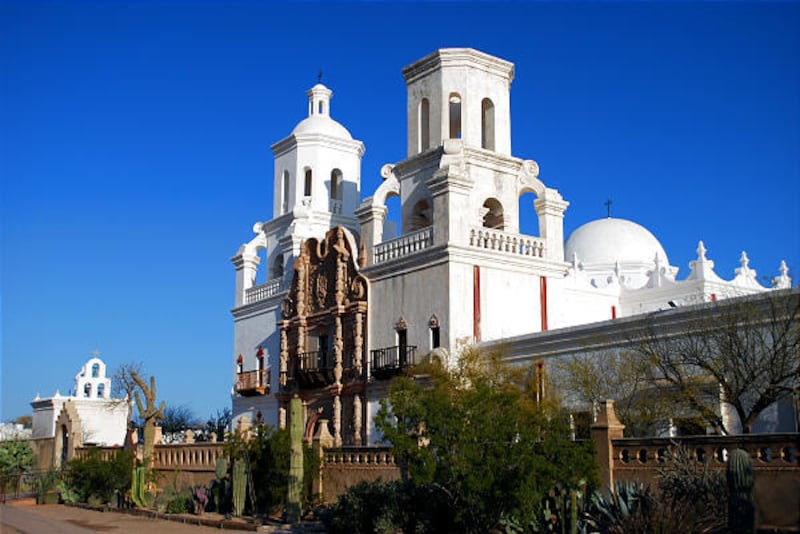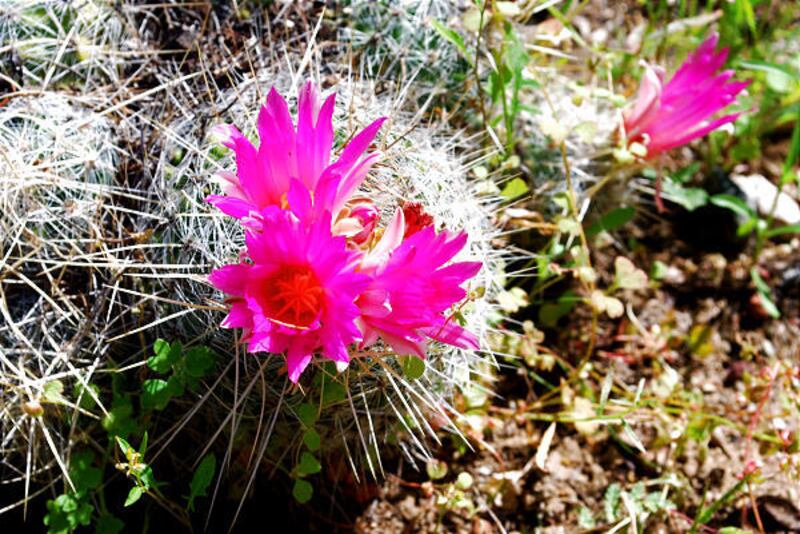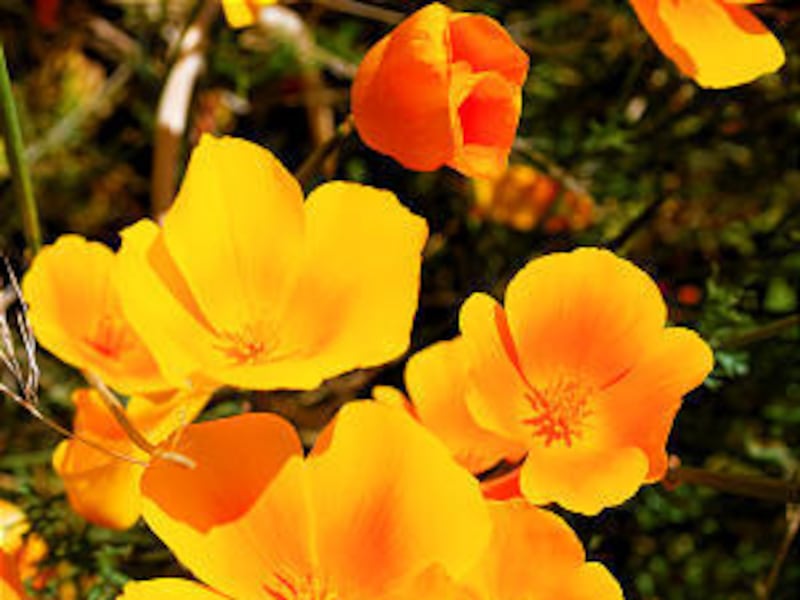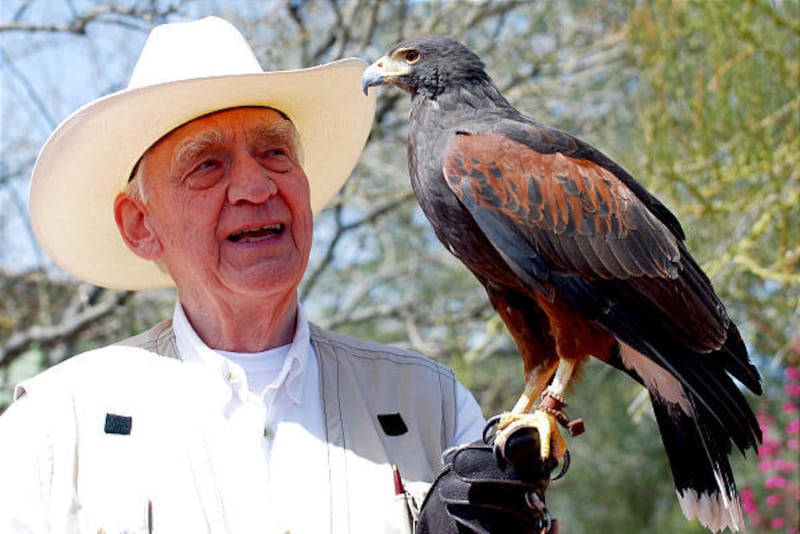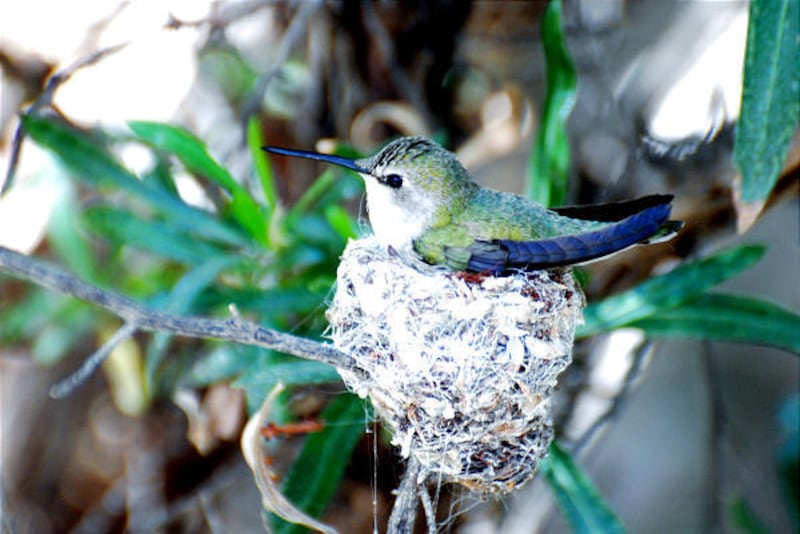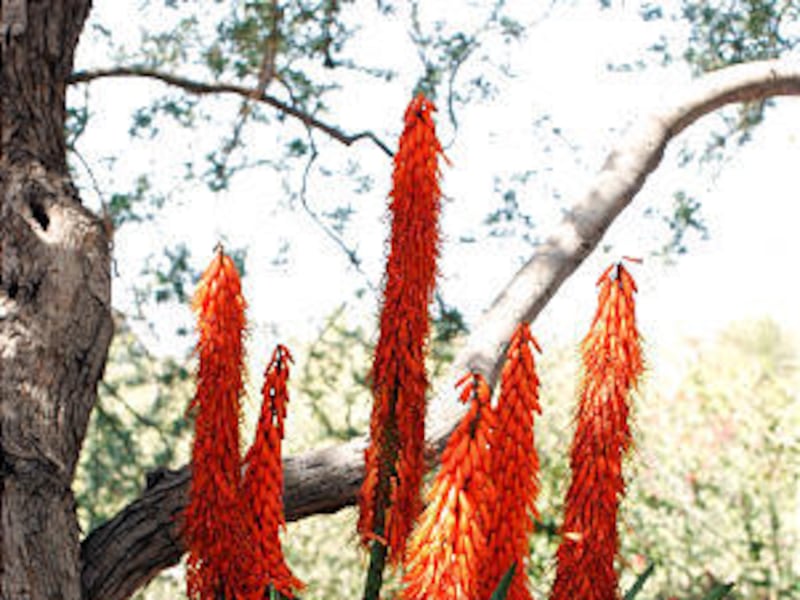TUCSON, Ariz. — Snow pellets pinged off our car as we began a dash south under somewhat forbidding skies. My brother-in-law Bud and I were hoping to enjoy a preliminary taste of true spring in Arizona where, according to various Web sites, desert flowers were brightening the landscape around Phoenix and Tucson.
We had decided, in effect, to become short-term, early-spring "snowbirds," but even as we drove down I-15, we saw a northward parade of RV campers towing smaller four-wheel-drives and sedans.
We suspected these were real "snowbirds": People who had anticipated the chill and snow of deep winter in places like Canada and Montana and, back in the autumn, migrated toward a milder winter in the Grand Canyon State.
But weren't they flying home just a little bit early?
For weeks I had been monitoring Web sites like DesertUSA.com to check out what eyewitnesses were seeing and reporting on its area-specific forum and picture pages.
For instance, for the Phoenix area "Paul" reported, with specificity, one weekend that "Mexican gold poppies are at peak today and probably for this next week on the south face of Peachville Mountain a few miles north of milepost #225 on (U.S.) Highway 60 just west of Superior, AZ."
And Paul, like others, posted lovely photographs to document what he had seen.
That's what we wanted to glimpse, too.
Our goal was to rove the springtime desert landscape for a few days, but also to visit two specific places where we were probably guaranteed to see flowers and learn something at the same time.
One planned stop would be the Boyce Thompson Arboretum State Park, southeast of Phoenix in the Superstition Mountains just outside of Superior on U.S. 60. The other: the Arizona-Sonora Desert Museum west of Tucson.
That turned out to be a most worthwhile plan.
Along the road
DesertUSA.com contributor "Paul," I would discover by accident, deduction and confirmation, is Paul Wolterbeek, volunteer program coordinator for the Boyce Thompson Arboretum.
He wasn't there during our visit, but I was given his card as a contact and we subsequently exchanged e-mails. Wolterbeek acknowledged that he has been a regular contributor to the DesertUSA Web site for several years, keeping wanderers like me up to date.
On our first morning in Phoenix, Bud and I headed toward the Superstition Mountains via U.S. 60 and ventured toward Superior, the arboretum and Tonto National Forest after hitting Florence Junction.
Our general impression of the valley desert was: green.
Grasses are growing profusely. The cholla, a many-limbed desert plant of all sizes, looked fluffy and verdant (if spiky). Flowers are mostly flourishing along the roadsides — with an especially eye-catching bounty at the mouth of the canyon into Tonto National Forest.
"This year Highway 60 approaching the arboretum from Phoenix is particularly colorful," Wolterbeek agrees.
Road construction in the area, completed last year, "left the roadsides seeded with counter's lupine, Parry's penstemon and some unusual flowers such as chia, too." There are also golden Mexican poppies down the slope, and on the scenic hillsides across the way stand towering saguaro sentinels.
"Flowers along Highway 60 should continue blooming through mid-April, possibly later in the month," Wolterbeek says.
And U.S. 60 is not the only "highway garden" in the state.
The Arizona Department of Transportation's Roadside Development Office plants and seeds roadsides and medians in urban areas, and seeds mile after mile along the rural highways, says Laura Douglas, an ADOT spokesperson.
Bud and I saw long expanses in bloom along Arizona's cross-country routes. Douglas says I-10, for instance, is seeded pretty much all the way from the California border to the New Mexico border.
The ADOT seed mix includes such flowers and plants as brittlebush, desert marigold, orange desert globe mallow, Arizona bluebells, owl's clover, desert senna, Mexican poppies — and something called "bladderpod."
"They're useful as well as beautiful," she says.
The pretty plants help stabilize the ground, control weeds and prevent tumbleweeds, she says.
Desert arboretum
About 55 miles southeast of Phoenix, Boyce Thompson Arboretum is just off U.S. 60 before those traveling east would arrive at the old mining town of Superior. It is nestled in the canyon carved by Queen Creek beneath the gnarly cliffs of Picketpost Mountain.
"March and April are the busiest months all year" at the arboretum, which accommodates thousands of visitors each day, about 75,000 to 80,000 each year, Wolterbeek says. Up to a third of them drop by "during these two sublime spring months."
The arboretum is the namesake of Col. William Boyce Thompson, an Arizona mining magnate fascinated with plants, and desert plants in particular. His goal in founding the arboretum, notes a large informational placard in one greenhouse, was to showcase Arizona and Southwest plants, but also to introduce people to species from around the world.
Today the site offers a maze of looping trails, short and long, though only about 100 of the 1,075 acres are actually open to the public, according to a the park.
One path, the brief Curandero Trail, presents the native flora of the area's Sonoran Desert, with placards noting their names — and their culinary and medicinal possibilities.
Other trails feature plants of the nearby Chihuahuan Desert and from the deserts of South America and Australia, as well as a legume garden, a cactus garden, an herb garden and more. Hikers can circumnavigate the nearby uplands and riparian areas by following he longest trail, around Magma Ridge.
"We usually offer guided walks, which are open to all who show up at tour time," Wolterbeek says. "Wildflowers are blooming along the trails, and migrant songbirds such as Lucy's warbler and Bell's vireo are returning to nest — it's a great season to visit."
At 11 a.m. each Saturday in April a volunteer from the Arizona Native Plants Society guides a wildflower walk, helping visitors identify "poppies, penstemons, lupines and a couple dozen other varietals," he says. The staff also posts weekly wildflower updates on the arboretum's Web site, on DesertUSA.com's Arizona wildflower report page, and at the Desert Botanical Garden's statewide wildflower page.
Although very few cacti were flowering during our visit, many barrel cactuses were pregnant with buds.
"The great thing about spring in Arizona is that annual flowers in March and April yield the floor to cactus blossoms in late April, May and into June," Wolterbeek says.
First come the purple-flowered hedgehog cacti, he says, then the yellow-and-red opuntia varieties, then the white-blossomed saguaro in May and June — the latter Arizona's state flower.
"At Boyce Thompson Arboretum in our Demonstration Garden we have a mix of native wildflowers, cacti, trees and other plants which reach their peak around Mother's Day weekend," Wolterbeek says.
Rains of winter
"Arizona has had tremendous rainfall this winter, which is helping the flower growth," Douglas says.
Indeed, "wildflowers are surprisingly vivid this year, thanks to heavier-than-usual winter rains," Wolterbeek would add.
Practically all of Arizona has experienced an unusually wet winter, partially attributable to El Niño, confirms Paul Iñiguez, meteorologist with the National Oceanic and Atmospheric Administration's National Weather Service in Phoenix.
"El Niño," he says "is a periodic (about every 3-7 years) warming of the equatorial waters in the Pacific Ocean. When the sea surface temperatures are warmer than normal, as is the case with El Niño, it has a profound impact on global weather patterns."
One of those effects is more precipitation in winter in the American Southwest, Iñiguez says.
Since January, Phoenix has recorded 4.88 inches of rain (as of this writing); normal is 2.67 inches. Tucson has received 4.51 inches, while 2.68 inches is normal. By contrast, areas of the Kaibab Plateau to the north have not had quite as wet a winter, he says.
"The wet winter has resulted in the reservoirs northeast of Phoenix being completely filled, which is of course good for water users," Iñiguez says. "The drought that had been ongoing has subsided for all but northeast Arizona.
"The desert the last month or so has really started to green up — a lot of desert grass has grown in, and what normally looks brown now has a green hue. Desert flowers have also begun to bloom."
Of course, Iñiguez adds, Arizona is also familiar with the opposite of El Niño: La Niña. "This is when the (ocean) waters are cooler than normal and can result in drier winters."
And that means less grass and fewer flowers in the Arizona desert.
Museum in the desert
Over a low range from Tucson proper, the Arizona-Sonora Desert Museum is in a rural setting with neighbors like Tucson Mountain Park, Old Tucson park and a district of Saguaro National Park. I'd visited the desert museum before, and with Bud was eager to drop by again — for it has to be considered one of the best of its kind in the world.
With both indoor and outdoor (as well as above-ground and below-ground) components, it is a multifaceted experience, part botanical garden, part natural history museum and part zoo, along with restaurants, snack bars and gift shops.
Founded in 1952, the 21-acre "museum" is, of course, dedicated to the wonders of the Sonora Desert, which besides occupying this part of Arizona, stretches into Southern California and well into Mexico and the Baja California peninsula.
On the grounds, notes the museum's self-guiding tour map, "you will see more than 300 animal species and 1,200 kinds of plants on display — alive in their natural desert settings."
Rattlesnakes coil inside glassed habitats, along with other serpents, lizards, iguanas and such. And scattered along paths bordered by cacti, yuccas, agaves and a zillion other plants are enclosures where we caught sight of an otter playfully swimming in a pool, two Mexican wolves pacing in broad up-and-down ovals, a pair of bobcats in the shade, one licking the fur of another, a mountain lion and many other birds and animals.
Docents greet, guide and show off wonderful birds and other creatures in close proximity. (The fellow who led us through the gates was an admitted snowbird who has houses in both Arizona and Iowa.)
John Mistler had a small, burnished kestrel on his gloved hand. Zona Madden introduced us to a small, serious-looking screech owl. Charles J. Erickson had an adult Harris's hawk, with beautiful plumage of gray, chestnut and white, on his covered hand and arm.
"When I first come out, he weighs only a few pounds, but after awhile if feels like he must weigh 500 pounds," Erickson joked as the handsome raptor looked this way and that with piercing eyes.
Martin and Holly Prows of Chandler, Ariz., devoted a lovely spring day to a family outing at the museum with their children Aidan and Halle.
While the children enjoyed the complex's caves and animals, Holly and Martin were impressed with the serenity and unexpected desert beauty.
"We loved how the majority of the trail was accessible for children traveling in a double-long stroller," Holly Prows says. "And that there were plenty of resting spots to enjoy the tranquility."
Their children communicate primarily with sign language, and the things they saw had them signing away even before the family arrived.
"Halle talked about snakes on our way there – we told her we were going to see some," she says. And after the visit the two were signing about lizards and spiders and a baby rabbit they saw in the agave garden.
The Prows family will also remember the visit with photos that captured Aidan trying on bat ears – while signing "bat" – and both Halle and Aidan sitting on a turtle sculpture, signing "turtle."
"It's a beautiful place," Holly Prows says. "We are grateful to have been able to enjoy such a well-kept park."
Homeward bound
Our route home took us through central and western Arizona on highways lined with wildflowers – and not all were seeded by ADOT.
Hillsides bristling with tall saguaro and other cacti and brush had a yellow hue testifying to flowery ground cover.
As we drove homeward, Bud and I couldn't help but notice scores of license plates on Winnebagos and trucks towing trailers from northern provinces.
"Saskatchewan," Bud would note from the passenger seat. "Another Alberta. British Columbia." Surely the majority of them carried true snowbirds.
And, after several days with temperatures in the 70s and low 80s, before we could make it home, we were hit by a true blizzard in Cedar City and snow squalls all along I-15.
Our few days in Arizona in search of desert flowers proved to be a spring break indeed.
If you go...
Arizona botanical sites:
Arizona-Sonora Desert Museum: 2021 N. Kinney Road, Tucson, Ariz.; telephone: 520-883-1380; Web: desertmuseum.org
Boyce Thompson Arboretum: 37615 E. U.S. 60, Superior, Ariz., 85273; telephone: 520-689-2723; Web: arboretum.ag.arizona.edu/
Other Arizona arboretums:
The Arboretum at Arizona State University, Tempe — Web: uabf.asu.edu/arboretum
The Arboretum at Flagstaff — Web: thearb.org
Desert Botanical Garden, Phoenix — Web: dbg.org
Tucson Botanical Gardens — Web: tucsonbotanical.org
Arizona wildflower Web links:
Boyce Thompson Arboretum wildflower page
Arizona State Parks' "Ranger Cam" flower photos and reports
DesertUSA's statewide report for Arizona
Desert Botanical Garden's Arizona report page
About El Nino
NOAA Climate Prediction Center (information and graphs)
e-mail: features@desnews.com


